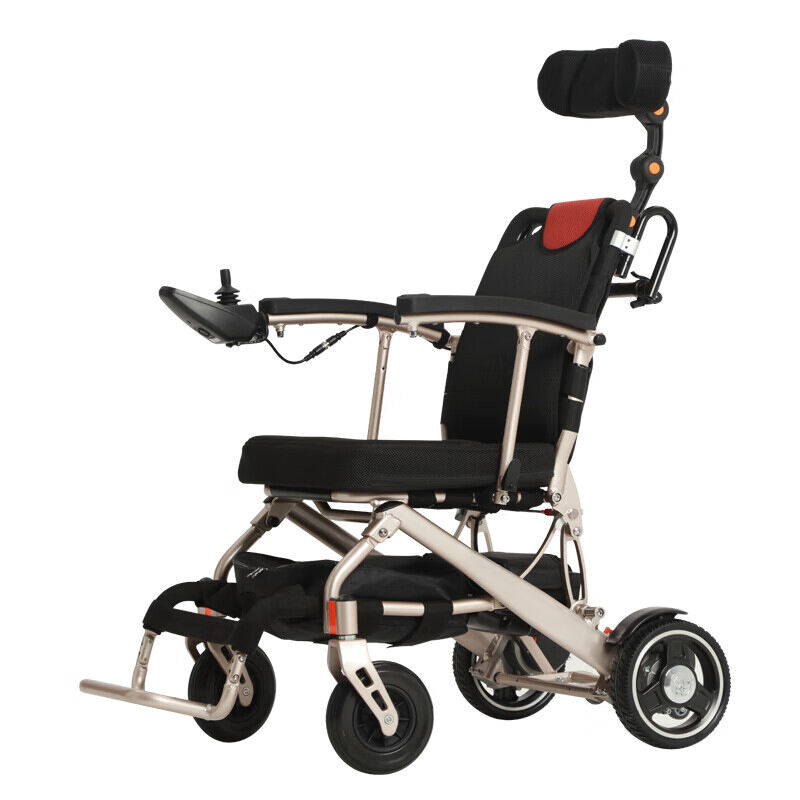지난 수십 년간 세계 이동 보조기기 시장은 고령화 인구 증가, 이동 장애 발생률 상승 및 의료 지출 확대에 힘입어 놀라운 성장을 이루어 왔습니다. 다양한 이동 솔루션 중에서도 전기 휠체어 수요가 높고 마진이 큰 기회를 추구하는 유통업체들에게 전략적 제품으로 부상하고 있다. 최근의 업계 보고서에 따르면, 글로벌 전동 휠체어 시장은 다가올 5년간 연평균 성장률(CAGR) 7~8%로 성장할 것으로 예상되며, 이는 선진 지역에서의 채택과 더불어 신흥 시장에서의 인식 확산을 반영한다.
이러한 성장을 견인하는 여러 요인이 있다. 첫째, 세계적으로 고령화 인구가 증가하면서 독립성과 이동성을 향상시키는 제품에 대한 수요가 커지고 있다. 둘째, 배터리 수명 연장 및 제어 시스템 개선과 같은 기술 발전 덕분에 전동 휠체어 가 가정 간병과 기관 환경 모두에서 장기 사용에 더욱 매력적으로 다가가고 있다. 셋째, 보조기기 접근성 증진을 위한 정부 정책과 보조기기 구매 지원 프로그램은 소비자와 의료기관의 추가적인 구매 유인을 창출하고 있다.
유통자 입장에서 이러한 시장 역동성은 전략적 기회를 제공합니다. 제품들 전동 휠체어 즉, 사용자의 즉각적인 요구를 충족시킬 뿐만 아니라 편의성, 안전성, 신뢰성을 강조하는 장기적인 시장 추세를 해결합니다. 이동 장비 공급업체들 간의 경쟁이 심화되면서, 첨단 전기 이동 솔루션에 대한 투자는 브랜드 차별화와 지속 가능한 수익을 보장합니다.
또한 시장에서는 다기능적이고 적응 가능한 솔루션에 대한 수요가 증가하고 있습니다. 소비자들은 이제 내구성과 신뢰성뿐만 아니라 다재다능한 디자인으로 이동 장비를 선호합니다. 이 추세는 전동 휠체어 배터리 수명이 길어지고, 조정 가능한 컨트롤과 복사 가능한 구조로 여러 환경과 사용 사례를 통해 작동할 수 있습니다.

이 사업의 전략적 가치 전기 휠체어 사용 편의성과 운영 효율성을 모두 고려하는 핵심 기능과 밀접하게 연결되어 있습니다. 가장 중요한 측면 중 하나는 장거리 배터리 시스템 이를 통해 사용자는 외부에서 장시간 동안 휠체어를 사용할 수 있으며, 자주 충전할 필요가 없습니다. 고품질 리튬이온 배터리는 일관된 성능을 보장하고 다운타임을 줄이며, 사용자가 일상 활동에서 이 장치에 신뢰하고 의존할 수 있도록 해줍니다. 유통업체의 경우, 신뢰할 수 있는 배터리 성능을 갖춘 제품을 홍보함으로써 고객 만족도를 높이고 보증 관련 클레임을 줄일 수 있습니다.
또 다른 핵심 특징은 다양한 제어 옵션 의 제공입니다. 많은 전기 휠체어들이 조이스틱과 원격 제어 인터페이스를 모두 제공하여 다양한 사용자의 능력과 선호에 맞는 유연성을 제공합니다. 이러한 적응성은 손가락 운동 능력이 제한된 사용자나 조작 시 도움을 주는 간병인들에게 접근성을 높여줍니다. 유통업체는 이러한 다목적성을 통해 개인 구매자뿐 아니라 병원 및 재활 센터와 같은 기관 고객까지 포괄할 수 있어 잠재 시장을 확대할 수 있습니다.
그 접이식 및 조절 가능한 디자인 현대 전기 휠체어의 시장 매력을 더욱 강화합니다. 가볍고 접이 가능한 프레임은 쉽게 운송 및 저장 할 수 있으며 조정 가능한 좌석과 발받침 구성은 다양한 체형과 편안한 요구 사항을 수용합니다. 이 같은 디자인은 가정 사용, 여행, 그리고 지역 내 산책에 이상적입니다. 최종 사용자들이 편리함과 독립성을 모두 제공함으로써. 유통업체 입장에서는 제품의 다중 시나리오 적응력이 더 높은 판매 잠재력을 지원하고 전기 휠체어를 고급 다재다능 이동 솔루션으로 배치합니다.
또한 안전성 및 내구성 기능은 제품 성능에 필수적입니다. 현대 전기 휠체어에는 종종 굴림 방지 장치, 강화된 프레임, 충격 흡수 바퀴가 포함되어 다양한 지형에서 안정적으로 작동하도록 보장합니다. 이 기능들은 Ergonomic 좌석과 결합하여 편안함을 향상시킬 뿐만 아니라 부상의 위험을 줄여서 장기적인 사용에 적합하게 만듭니다.
배터리 수명, 멀티 모드 제어, 접이식 및 조절 가능한 디자인, 그리고 강력한 안전 기능을 결합함으로써, 전기 휠체어 이동성 보조기 시장에서 고부가가치 제품으로 돋보인다. 이런 기능이 풍부한 기기를 저장하고 판매하는 유통업체들은 고객들의 충성도를 얻고 지속 가능한 비즈니스 성장을 달성할 가능성이 높습니다.
이동 지원 부문에서의 조달 패턴은 기술 발전과 시장 수요로 인해 크게 발전했습니다. 유통업체는 점점 더 높은 품질의 제품을 우선시하고 있습니다. 전동 휠체어 단지 초기 비용에만 집중하는 것이 아니라 장기적인 가치를 제공하는 것입니다. 내구성, 배터리 사용시간이 길고, 적응 가능한 디자인이 좋은 제품은 서비스 비용을 줄이고 의료기관과의 장기적인 파트너십을 지원하기 때문에 선호됩니다.
주요 추세 중 하나는 대량 기관 조달 병원, 재활 센터 및 노인 요양 시설들은 다양한 사용자 요구를 충족하는 기능이 풍부한 전동 휠체어를 포함하도록 이동 보조 장비를 업데이트하고 있습니다. 고품질 모델에 대한 안정적인 공급과 기술 지원을 제공할 수 있는 유통업체는 협상 및 장기 계약에서 유리한 위치를 차지하고 있습니다.
또 다른 부상하는 추세는 소비자 직접 판매 및 온라인 유통 입니다. 소비자들은 점점 더 온라인에서 이동 보조 장치를 조사하고 구매하며, 다용도성, 편안함, 신뢰할 수 있는 성능을 갖춘 제품을 우선적으로 선택합니다. 유통업체들은 접이식, 조절 가능한 전동 휠체어와 같은 다양한 제어 방식과 긴 배터리 수명을 갖춘 제품을 조달하여 확보해야 합니다. 이러한 특성은 이커머스 마켓플레이스에서 높은 평가를 받기 때문입니다.
지속가능성 및 내구성 강력한 설계나 효율적인 배터리 시스템으로 인해 덜 자주 교체가 필요한 제품들이 기관 구매자와 개인 소비자 모두에게 선호되고 있으며, 이러한 제품을 보유함으로써 애프터서비스 비용을 줄이고 품질에 대한 평판을 높일 수 있다는 점을 유통업체들이 인지하고 있습니다.
글로벌 공급망 관리 또한 중요한 요소입니다. 유통업체들은 일관된 품질과 국제 안전 기준 준수, 그리고 정시 납품을 보장할 수 있는 제조업체 및 공급업체를 선호합니다. 이를 통해 전동 휠체어와 같은 수요가 높은 제품들도 시장 상황이 불안정하더라도 지속적으로 공급될 수 있습니다.
마지막으로, 맞춤형 옵션이 점차 주목받고 있습니다. 소비자들은 좌석 조절, 제어 설정 또는 접이식 디자인 등 특정 요구에 맞게 조정 가능한 전동 휠체어를 점점 더 선호하고 있습니다. 신뢰할 수 있는 공급업체를 통해 이러한 옵션을 제공할 수 있는 유통업체는 다양한 고객 요구를 충족함으로써 경쟁 우위를 확보할 수 있습니다.

그 전기 휠체어 다양한 산업과 사용자 세그먼트 전반에 걸쳐 관련성이 있습니다. 특히 의료 부문 병원, 재활 센터 및 요양원은 중요한 수요 원입니다. 다양한 기능을 갖춘 전동 휠체어는 환자의 이동성을 향상시키고 간병인의 부담을 줄이며 보다 효율적인 임상 업무 흐름을 가능하게 합니다. 이러한 기관에 서비스를 제공하는 유통업체는 대량 조달 전략을 활용하여 장기 계약을 체결할 수 있습니다.
이 지역에서는 개인용 모빌리티 시장 노령 인구의 증가와 이동성 솔루션에 대한 인식 제고는 고품질 전기 휠체어 수요를 촉진하고 있습니다. 긴 배터리 수명, 다중 모드 제어 기능 및 접이식 프레임을 갖춘 제품은 가정 간병 사용자들 사이에서 특히 인기가 높으며, 편의성, 안락함, 독립성을 제공합니다. 이 시장을 타겟으로 하는 유통업체들은 이커머스 채널과 직접 판매 모델에 집중할 수 있습니다.
여행 및 교통 산업 또한 기회를 제공합니다. 항공사, 공공교통 시스템 및 숙박 서비스 제공업체는 자주 사용하기 위해 가볍고 내구성이 뛰어나며 접이식 전기 휠체어를 필요로 합니다. 이러한 사용 사례는 높은 신뢰성과 조작 용이성을 요구하며, 다양한 기능을 갖춘 모델을 유통업체의 전략적 재고로 자리매김하게 합니다.
부터 조달 전략 공급망 관점에서 유통업체는 일관되게 고품질 전동 휠체어를 공급하고, 맞춤형 옵션을 지원하며 국제 안전 기준을 준수할 수 있는 공급업체를 우선시해야 한다. 공급원을 다변화하고 여유 재고를 유지함으로써 시장 대응성을 확보할 수 있다. 간병인 및 최종 사용자 대상 교육, 보증 지원, 유연한 배송 옵션과 같은 부가가치 서비스를 제공하면 유통업체의 입지를 더욱 강화할 수 있다.
제품 선택을 시장 수요와 일치시키고 품질을 중시하며 최종 사용자 교육과 서비스를 지원함으로써 유통업체는 전동 휠체어를 이동 보조 장비 포트폴리오의 핵심으로 자리매김하고, 수익성과 장기적인 고객 만족을 모두 달성할 수 있다.
 핫 뉴스
핫 뉴스2025-05-15
2025-05-15
2025-05-15
2025-05-15

저작권 © 2025닝보 Ks 메디컬 테크 코., 리미티드. 모든 권리 보유 - 개인정보 보호정책